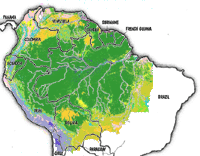
London: The earth's temperature may be 30 to 50 percent more sensitive to atmospheric carbon dioxide (CO2) than has previously been estimated, says a new study.
The results show that components of the earth's climate system that vary over long timescales - such as land-ice and vegetation - have an important effect on this temperature sensitivity, but these factors are often neglected in current climate models.
Dan Lunt, from the University of Bristol, and colleagues compared results from a global climate model to temperature reconstructions of the earth's environment three million years ago when global temperatures and CO2 concentrations were relatively high.
The temperature reconstructions were derived using data from three million-year-old sediments on the ocean floor.
"We found that given the concentrations of carbon dioxide prevailing three million years ago, the model originally predicted a significantly smaller temperature increase than that indicated by the reconstructions. This led us to review what was missing from the model," said Lunt.
The authors demonstrate that the increased temperatures indicated by the reconstructions can be explained if factors that vary over long timescales, such as land-ice and vegetation, are included in the model.
This is primarily because changes in vegetation and ice lead to more sunlight being absorbed, which in turn increases warming, said a Bristol release.
Climate models used by bodies such as the Intergovernmental Panel on Climate Change often do not fully include these long-term processes, thus these models do not entirely represent the sensitivity of the earth's temperature to CO2.
Alan Haywood, study co-author from the University of Leeds, said: "If we want to avoid dangerous climate change, this high sensitivity of the Earth to carbon dioxide should be taken into account when defining targets for the long-term stabilisation of atmospheric greenhouse-gas concentrations."
These findings were published in Nature Geoscience.

 Alan Haywood, study co-author from the University of Leeds, said: "If we want to avoid dangerous climate change, this high sensitivity of the Earth to carbon dioxide should be taken into account when defining targets for the long-term stabilisation of atmospheric greenhouse-gas concentrations."
Alan Haywood, study co-author from the University of Leeds, said: "If we want to avoid dangerous climate change, this high sensitivity of the Earth to carbon dioxide should be taken into account when defining targets for the long-term stabilisation of atmospheric greenhouse-gas concentrations."